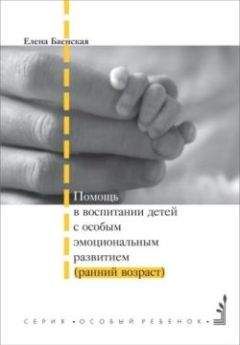88. Шереметьева Е.В. Предупреждение отклонений речевого развития у детей раннего возраста: Автореф. дис. канд. пед. наук. – М., 2007.
89. Шматко Н.Д. Новые формы организации коррекционной помощи детям с отклонениями в развитии //Дошкольное воспитание. – 1998. – № 3.
90. Шматко Н.Д., Пелымская Т.В. Если малыш не слышит…. – М.: Просвещение, 1995; 2003.
91. Шматко, Н.Д., Головчиц, Л.А., Стребелева, Е.А. Подходы к модернизации системы дошкольного образования детей с ограниченными возможностями здоровья /Н.Д.Шматко, Л.А. Головчиц, Е.А.Стребелева // Дефектология. – 2009. – № 1.
92. Щербанин Ю.А. Мировая экономика. Учебник. – М.: «Юнити – Дана», 2004.
93. Эмоции и отношения человека на ранних этапах развития / Под ред. Р.Ж.Мухамедрахимова. – СПб.: Издат. С.-Петерб. ун-та, 2008.
94. Ярыгин В.Н., Казьмин А.М., Казьмина Л.В., Петрусенко Е.А. и др. Российская лекотека: реальная помощь детям с особенностями развития // Современное дошкольное образование. – 2008. – № 1.
95. Ярыгин В.Н., Казьмин А.М., Казьмина Л.В., Петрусенко Е.А. и др. Российская лекотека: реальная помощь детям с особенностями развития // Современное дошкольное образование. – 2008. – № 2.
96. Ainsworth, M.D.S., Bowlby, J. (1991). An ethological approach to personality development. Amerikan Psychologist, Vol. 46, N 4.
97. Bailey, D., Hebbeler, K., Scarborough, A., Spiker, D., & Mallik, S. First experiences with early intervention: A national perspective. Pediatrics, 113 (4), 887–896.
98. Bailey, D., Hebbeler, K., Spiker, D., Scarborough, A., Mallik, S., & Nelson, L. (2005). 36-month outcomes for families of children with disabilities participating in early intervention. Pediatrics, 116, 1346–1352.
99. Bailey, D.B., Jr., Powell, T. (2005). Assessing the information needs of families in early intervention. In M.J. Guralnick (Ed.), The Developmental Systems Approach to Early Intervention (pp. 151–184). Baltimore: Paul H. Brookes Publishing Co.
100. Bandura, A. (1977). Social learning theory: New York.
101. Bandura, A., Walters, R. (1963). Social learning and personality development: New York.
102. Barry M. (1998). Social Exclusion and Social Work: an introduction. In: Barry M., Hallet C. Social Exclusion and Social Work: Issues of theory, Policy and Practice, Russell House Publishing, Dorset, 1–12.
103. Beckman, P.J., & Porkorni, J.L. (1988). A longitudinal study of families of preterm infants: Change in stress and support over the first two years. The Journal of Special Education, 22, 66–65.
104. Bjerck-Akesson, E. & Granlund, M. (2005. Early intervention in Sweden. In M.J. Guralnick (Ed.), The Developmental Systems Approach to Early Intervention (pp. 571–592). Baltimore: Paul H. Brookes Publishing Co.
105. Brazelton, T.B., Cramer, B.G. (1991). The earliest relationship. Parents, infants and the drama of early attachment. London.
106. Bronfenbrenner, U. (1979). The ecology of human development. Cambridge, MA: Harvard University Press.
107. Bruder, M.B. (1994) Working with members of other disciplines: Collaboration for success. In M. Wolery & J.S. Wilbers (Eds.), Including children with special needs in early childhood programs (pp. 45–70). Washington, DC: National Association for the Education of Young Children.
108. Bruder, M.B. (2005). Service coordination and integration in a developmental systems approach to early intervention. In M.J. Guralnick (Ed.), The Developmental Systems Approach to Early Intervention (pp. 29–59). Baltimore: Paul H. Brookes Publishing Co.
109. Carpenter, B., & Russell, P. (2005) Early intervention in the United Kingdom: current policy and practice. In M.J. Guralnick (Ed.), The Developmental Systems Approach to Early Intervention (pp. 455–480). Baltimore: Paul H. Brookes Publishing Co.
110. Cooper, J. H. An Early Childhood Special Education Primer. Chapel Hill, NC: Technical Assistance Development System (TADS), 1981.
111. Darling, R.B. & Darling, J. (1992). Early intervention: A field moving toward a sociological approach. Sociological Studies in Child Development, 5, 9–22.
112. Darling, R.B. & Peter, M.L. (Eds.). (1994). Families, physicians, and children with special health needs: Collaborative medical education models. Westport, CT: Greenwood.
113. Doherty, W. J. (1985). Family intervention in health care. Family Relations, 34, 129–137.
114. Dunst C.J., Johanson C., Trivette C.M., Hambry D. Family-oriented early intervention policies and practices: Family-centered or not? //Exceptional Children. – 1991. – Vol. 58.
115. Farran D.C. (2005) Developing and implementing preventive intervention programs for children at risk. In M.J. Guralnick (Ed.), The Developmental Systems Approach to Early Intervention (pp. 267–304). Baltimore: Paul H. Brookes Publishing Co.
116. Field, T. (1990). Infancy. London: Harvard University Press.
117. Fraiberg S. The development of human attachments in infant blind from birth // Merrill-Palmer Quarterly. – 1975. – Vol. 21. – P. 315–334.
118. Freud, A. (1965). Normality and pathology in childhood: assessments of development: New York.
119. Gilliam, W.S., & Mayes, L.C. (2004). Integrating clinical and psychometric approaches: Developmental assessment and the infant mental health evaluation. In R. DelCarmen-Wiggins & A. Carter (Eds.), Handbook of infant, toddler and preschool mental health assessment (pp. 185–203). NY: Oxford University Press.
120. Gilliam, W.S., Meisels, S.J, Mayes, L.C. (2005). Screening and surveillance in early intervention systems. In M.J. Guralnick (Ed.), The Developmental Systems Approach to Early Intervention (pp. 73–98). Baltimore: Paul H. Brookes Publishing Co.
121. Gine, C., Garcia-Die, M.T., Garcia, M.G., Momplet, R.V. (2005). Early intervention in Spain: an overview of current practices. In M.J. Guralnick (Ed.), The Developmental Systems Approach to Early Intervention (pp. 543–570). Baltimore: Paul H. Brookes Publishing Co.
122. Guralnick, M.J. (2001). A framework for change in early childhood inclusion. In M.J. Guralnick (Ed.), Early childhood inclusion: Focus on change (pp. 3-35). Baltimore: Paul H. Brookes Publishing Co.
123. Guralnick, M.J. (2001). Developmental systems model for early intervention. Infants and young children, 14(2), 1–18.
124. Guralnick, M.J. (2004). Family investments in response to the developmental challenges of young children with disabilities. In A. Kalil & T. Deleire (Eds.), Family investments in children`s potential: Resources and behaviors that promote success (pp. 119–137). Mahwah, NJ: Lawrence Erlbaum Associates.
125. Guralnick, M.J. (2005). Inclusion as a core principle in the early intervention system. In M.J. Guralnick (Ed.), The Developmental Systems Approach to Early Intervention (pp. 59–72). Baltimore: Paul H. Brookes Publishing Co.
126. Guralnick, M.J. (2005). The Developmental Systems Approach to Early Intervention (International Issues in Early Intervention). Baltimore: Paul H. Brookes Publishing Co.
127. Haley, J. (1963). Strategies of psychotherapy. Grune & Stratton, New York.
128. Hall, A.D. & Fagen, R.E. Definition of Sistem // In: Bertalanffy L. von & Rapoport A., 1956
129. Hanson, M.J. (2005). Ensuring effective transition in early intervention. In M.J. Guralnick (Ed.), The Developmental Systems Approach to Early Intervention (pp. 373–400). Baltimore: Paul H. Brookes Publishing Co.
130. Harbin, G., Bruder, M.B., Reynolds, C., Mazzarella, C., Gabbard, G., & Staff, I. (2002). Service coordination policies and models: National status. Chapel Hill: Frank Porter Graham Child Development Institute, University of North Carolina.
131. Harbin, G.L. (2005). Designing an integrated point of access in the early intervention system. In M.J. Guralnick (Ed.), The Developmental Systems Approach to Early Intervention (pp. 99–132). Baltimore: Paul H. Brookes Publishing Co.
132. Hartman, A., & Laird, J. (1983). Family – centered social work practice. New Jork: Free Press.
133. Haug, M., & Lavin, B. (1983). Consumerism in medicine: Challenging physician authority. Beverly Hills: Sage.
134. Hauser-Cram, P., & Howell, A. (2003). The development of young children with disabilities and their families. In R. M. Lerner, F. Jacobs, & D. Wertlieb (Eds.), Handbook of applied developmental science (Vol.1, pp. 259–278). Thousand Oaks, CA: Sage.
135. Hebbeler, K. M., & Spiker, D. (2003). Initiatives on children with special needs. In J. Brooks-Gunn & L. Berlin (Eds.), Early child development in the 21st century: Profiles of current research initiatives (pp.269–325). New York: Teachers College Press.
136. Kazak, A., & Marvin, R. S. (1984). Differences, difficulties, and adaptation: Stress and social networks in families with a handicapped child. Family Relations, 33, 67–77.
137. Kazak, A., & Wilcox, B. (1984). The structure and function of social support networks in families with handicapped children. American Journal of Community Psychology, 12, 645–661.
138. Latham, M.C. (1977). Infant feeding in national and international perspective: An examination of the decline in human lactation, and the modern crisis in infant and young child feeding practices. Annats of the New York Academy of Sciences, 300. 197–209.
139. Lorenz, K.Z. (Ed. by C.H.Schiller) (1957). The companion in the bird's world. Instinctive behaviour: New York.
140. Mahler, M.S. et al. (1975). The Psychological Birth of the Human Infant: New York.
141. McCubbin, H.L., & Patterson, J.M. (1983). The family stress process: The double ABCX model of adjustment and adaptation. Marriage and Family Review, 6, 7–37.
142. McWilliam, R.A. (2005) Assessing the resource needs of the families in the context of early intervention. In M.J. Guralnick (Ed.), The Developmental Systems Approach to Early Intervention (pp. 215–234). Baltimore: Paul H. Brookes Publishing Co.
143. Meisels, S.J., & Atkins-Burnett, S. (2000). The elements of early childhood assessment. In J.P. Shonkoff & S.J., Meisels (Eds.), Handbook of early childhood intervention (2nd ed., (pp. 231–257). NY: Cambridge University Press.
144. Mercer, J.R. (1965). Social system perspective and clinical perspective: Frames of reference for understanding career patterns of persons labeled as mentally retarded. Social Problems, 13, 18–34.
145. Minuchin, S. (1974). Families and family therapy. Cambridge, MA: Harvard University Press.
146. Mitchell, D. (1983). Guidance needs and counseling of parents of mentally retarded persons: In N.N. Singh & K. M. Wilton (Eds.), Mental retardation: Research and services in New Zealand. 136–156. Chistchurch, New Zealand: Witcoulls.
147. Orsmond, G.I. (2005). Assessing interpersonal and family distress and threats to confident parenting in the context of early intervention. In M.J. Guralnick (Ed.), The Developmental Systems Approach to Early Intervention (pp. 185–214). Baltimore: Paul H. Brookes Publishing Co.
148. Pretis., M. (2005). A developmental communications model within the Early Intervention System in Austria. In M.J. Guralnick (Ed.), The Developmental Systems Approach to Early Intervention (pp. 425–438). Baltimore: Paul H. Brookes Publishing Co.
149. Rahman, M., Palmer, G., Kenway, P., Howarth, C. (2000). Monitoring Poverty and Social Exclusion. York: Joseph Rowntree Foundation.
150. Scarborough, A. A., Hebbeler, K. M., Simeonsson, R. J., & Spiker, D. (2007). Caregiver descriptions of the developmental skills of infants and toddlers entering early intervention services. Journal of Early Intervention, 29(3), 207–227.
151. Scarborough, A. A., Hebbeler, K. M., Spiker, D., & Simeonsson, R. J. (2007). Dimensions of behavior of toddlers entering early intervention: Child and family correlates. Infant Behavior and Development, 30, 466–478.
152. Scarborough, A. A., Spiker, D., Mallik, S., Hebbeler, K., Bailey, D., & Simeonsson, R. J., (2004). A national look at children and families entering early intervention. Exceptional Children, 70(4), 469–483.
153. Sears, R. (1975). Insights on the child development movement in United States: Monographs of the Society for Research in child Development.
154. Sears, R., Maccoby, I., Levin, H. (1957). Pattern of child rearing: New York.
155. Shonkoff, J. P., P. Hauser-Cram. Early Intervention for Disabled Infants and Their Families: A Quantitative Analysis. Pediatrics 80 (1987): 650–658.
156. Simeonsson, R. J., Scarborough, A. A., & Hebbeler, K. M. (2006). ICF and ICD codes provided a standard language of disability in young children. Journal of Clinical Epidemiology, 59, 364–372.
157. Skinner, B.F. (1969) Contingencies of reinforcement: a theoretical analysis: New York.
158. Skinner, B.F., Ferster, C.B. (1957). Shedules of reinforcement: New York.
159. Spiker, D., Hebbeler, K., & Mallik S. (2005). Developing and implementing programs for children with established disabilities. In M.J. Guralnick (Ed.), The Developmental Systems Approach to Early Intervention (pp. 305–350). Baltimore: Paul H. Brookes Publishing Co.
160. Spiker, D., Hebbeler, K., & Mallik, S. (2005). Developing and implementing early intervention programs: Children with established disabilities. In M. J. Guralnick (Ed.), A developmental systems approach to early intervention: National and international perspectives (pp. 305–349). Baltimore: Paul H. Brookes Publishing.





